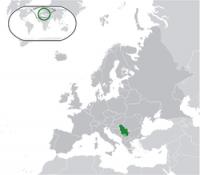
|
| Common name | Serbia | | Local name | | | Name | | | Anthem | Боже правде / God of justice
| | Capital | Belgrade | | Largest city | capital | | Official languages | Serbian1 | | Ethnic groups | 82.9% Serbs,
3.9% Hungarians,
1.8% Bosniaks,
1.4% Roma,
10.0% others
(excluding Kosovo) (2002) | | Demonym | Serbian | | Government | Parliamentary republic | | President | Boris Tadić | | Prime Minister | Mirko Cvetković | | Formation | Formation | | First state | 768 | | Kingdom | 1217 | | Empire | 1346 | | Recognized as suzerain principality | 1817 | | De-jure independence | 1878 | | Independent republic | 2006 | | Total Area | 34 116 sq mi (88.1 km2) (112th) | | Water % | 0.13
(including Kosovo) | | Population Est. | 7,387,367
(excluding Kosovo) | | Density (pop.) | 114.6/km2 (94th) (297/sq mi) | | GDP PPP | $79.013 billion (2011) (75th) | | GDP (PPP) per capita | $10,661 (excluding Kosovo) (74th) | | GDP (nominal) | 46.444 billion (2011) (80th) | | GDP (nominal) per capita | $6,267 (excluding Kosovo) (79th) | | Gini | 26 (2008) (low) | | HDI | 0.735 (2010) (high) (60th) | | Currency | Serbian dinar (RSD) | | Time zone | CET (UTC+1) | | - Summer (DST) | CEST (UTC+2) | | Drives on the | right | | Internet TLD | .rs, .срб | | Calling code | 381 |
|
|
Serbia c-enaudio=en-us-Serbia.oggˈsɜrbiə, officially the Republic of Serbia ( ), is a landlocked country located at the crossroads of Central and Southeast Europe, covering the southern part of the Carpathian basin and the central part of the Balkans. Serbia borders Hungary to the north; Romania and Bulgaria to the east; the Republic of Macedonia to the south; and Croatia, Bosnia and Herzegovina, and Montenegro to the west; additionally, it borders Albania through Kosovo, whose status as part of Serbia is disputed. The capital of Serbia, Belgrade, is among the largest cities in Southeast Europe.
After the arrival of the Serbs to the Balkans in the 7th century, several medieval states were formed, which evolved into the Serbian Empire in the 14th century. By the 16th century, Serbia was conquered and occupied by the Ottoman Empire, at times interrupted by the Habsburgs. In the early 19th century the Serbian revolution re-established the country as the region's first constitutional monarchy, which subsequently expanded its territory and pioneered the abolition of feudalism in the Balkans. The former Habsburg crownland of Vojvodina united with Serbia in 1918. Following World War I, Serbia formed Yugoslavia with other South Slavic peoples which existed in several forms up until 2006, when Serbia regained its independence. In February 2008 the parliament of UNMIK-governed Kosovo, Serbia's southern province, declared independence, with mixed responses from international governments.
Serbia is a member of the UN, Council of Europe, PfP, BSEC and CEFTA. It is also an potential candidate for EU membership and a self-declared neutral country.
|
|
|




 RSS
RSS